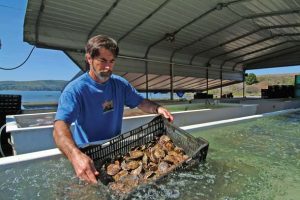Bodega Bay: Oysters, Abalone, and Ocean Acidification
Bodega Bay: Oysters, Abalone, and Ocean Acidification
- Registration fee: $25 (lunch included)
- Details: Wear comfortable walking shoes
- Organizer: Kat Kerlin, UC Davis Strategic Communications
- Sponsored by: UC Davis Strategic Communications

Terry Sawyer holds a bin of oysters at Hog Island Oyster Co. off Tomales Bay. He’s working with UC Davis scientists to help monitor ocean acidification levels for his crop.
NOTE: Start and end times given for field trips are the times when the trips depart from and return to the Marriott Marquis San Francisco.
The West Coast is prized for its productive fisheries and stunning coastlines, but warming temperatures and rising acidity are causing changes previously unseen in the Pacific. See how shellfish farmers at Hog Island Oyster Company in Tomales Bay are working with scientists from the UC Davis Bodega Marine Laboratory to proactively face those changes – and taste some of the West’s best oysters. Learn how ocean acidification is threatening oysters, mussels and other shellfish, and how seagrass may help buffer the oysters from the effects of climate change.
Then travel to Bodega Marine Laboratory itself, which boasts one of the best office views in the country. See how “Minion”-like robots are revealing surprising ways marine larvae move, and what that means for the ocean. Visit a captive breeding program that is the last hope for endangered white abalone, which were overfished nearly to extinction. And talk with experts about how other marine species are expected to fare under climate change.

LarvaeBot: Steven Morgan deploys a larvae-mimicking robot into Bodega Bay.

Kristin Aquilino and a white abalone at the UC Davis Bodega Marine Lab, where Aquilino heads the white abalone captive breeding program.
Above: View of UC Davis Bodega Marine Laboratory.

